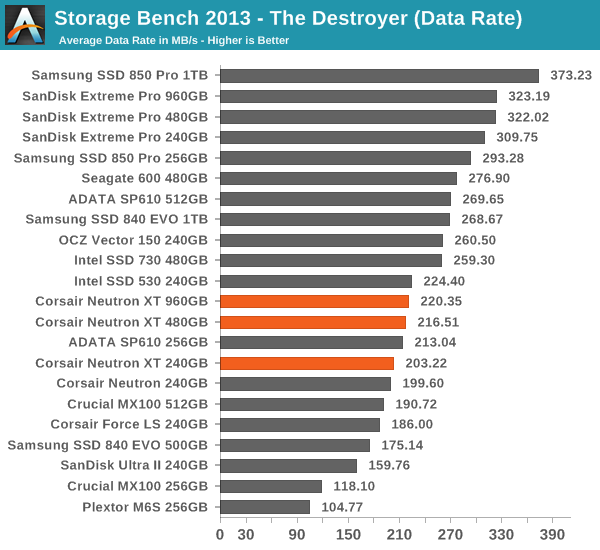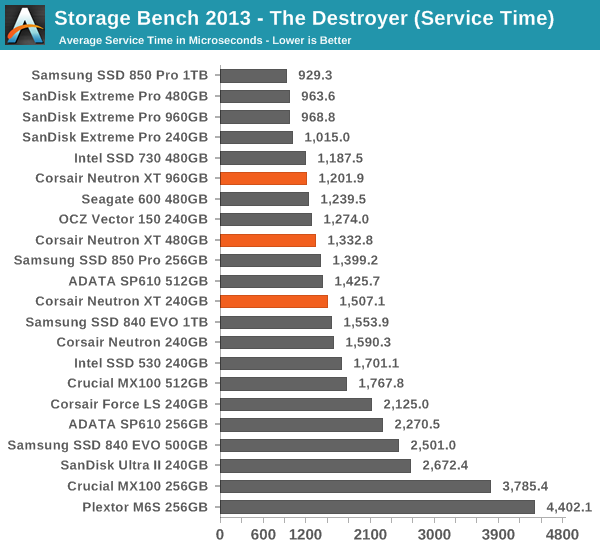Corsair Neutron XT (240GB, 480GB & 960GB) SSD Review: Phison S10 Debuts
by Kristian Vättö on November 17, 2014 9:00 AM ESTAnandTech Storage Bench 2013
Our Storage Bench 2013 focuses on worst-case multitasking and IO consistency. Similar to our earlier Storage Benches, the test is still application trace based – we record all IO requests made to a test system and play them back on the drive we are testing and run statistical analysis on the drive's responses. There are 49.8 million IO operations in total with 1583.0GB of reads and 875.6GB of writes. I'm not including the full description of the test for better readability, so make sure to read our Storage Bench 2013 introduction for the full details.
| AnandTech Storage Bench 2013 - The Destroyer | ||
| Workload | Description | Applications Used |
| Photo Sync/Editing | Import images, edit, export | Adobe Photoshop CS6, Adobe Lightroom 4, Dropbox |
| Gaming | Download/install games, play games | Steam, Deus Ex, Skyrim, StarCraft 2, BioShock Infinite |
| Virtualization | Run/manage VM, use general apps inside VM | VirtualBox |
| General Productivity | Browse the web, manage local email, copy files, encrypt/decrypt files, backup system, download content, virus/malware scan | Chrome, IE10, Outlook, Windows 8, AxCrypt, uTorrent, Ad-Aware |
| Video Playback | Copy and watch movies | Windows 8 |
| Application Development | Compile projects, check out code, download code samples | Visual Studio 2012 |
We are reporting two primary metrics with the Destroyer: average data rate in MB/s and average service time in microseconds. The former gives you an idea of the throughput of the drive during the time that it was running the test workload. This can be a very good indication of overall performance. What average data rate doesn't do a good job of is taking into account response time of very bursty (read: high queue depth) IO. By reporting average service time we heavily weigh latency for queued IOs. You'll note that this is a metric we have been reporting in our enterprise benchmarks for a while now. With the client tests maturing, the time was right for a little convergence.

The Neutron XT offers a healthy performance boost over the Force LS in our 2013 Storage Bench, but overall ends up in the middle-class. The Phison S10 platform appears to be very competitive with Silicon Motion's SM2246EN (ADATA SP610 in the graphs), but it can't challenge the high-end drives from Samsung, SanDisk, and OCZ.











56 Comments
View All Comments
hojnikb - Monday, November 17, 2014 - link
Because they are using samsung's controllers. And they already have pci-e controllers.close - Monday, November 17, 2014 - link
Because Apple only has to worry about their own product, and their PCIe SSDs come attached to a device capable of using it. So you don't buy a PCIe SSD, you buy an Apple device that comes with a PCIe SSD inside. Other integrators/OEMs don't care to do it as it increases costs so it's suitable only for high end. For now. Apple is doing it because it would seem that their customers can afford to pay the premium regardless of other aspects.Kristian Vättö - Monday, November 17, 2014 - link
There has been a handful of PCs with the XP941, but you are right that Apple is mostly the only one.The PC OEMs tend to cut in cost wherever possible because their margins are already razor thin. The XP941 is more expensive than SATA drives because it's the only PCIe x4 drive on the market and in addition the PC OEMs can use the same SATA drives in various models, whereas the XP941 would only fit in high-end models due to the cost.
For Apple this isn't an issue because the quantities they buy the XP941 in are so large and Apple also has a significant share of the high-end market, which is where the PC OEMs struggle. Plus Apple is one of the only companies that fully understand that it's the user experience that counts.
alaricljs - Monday, November 17, 2014 - link
> Plus Apple is one of the only companies that fully understand that it's the user experience that counts.Have to point out here that Apple is one of the only companies where the hardware is just another piece of the user experience puzzle that they have control over. Whereas for PC manufacturers it's almost the only part of the user experience they have control over.
Mikemk - Monday, November 17, 2014 - link
Apple needs to realize that again.warrenk81 - Tuesday, November 18, 2014 - link
thanks! i've been wondering about this since the MacBook Airs started with the PCIe SSDs in 2013.Shiitaki - Wednesday, November 19, 2014 - link
Apple produces the entire machine, so they don't have to worry about what the rest of the industry is or isn't doing. Because Apple can put the necessary driver support in their motherboard firmware to boot from a PCI-E drive. Apple also produces the operating system, so they can use a custom driver and not wait for 'official support'.Flunk - Monday, November 17, 2014 - link
Oh god I hope not, SATA Express' cable standards are a huge mess I hope we never need to deal with. Why we need yet another standard where M.2 makes massively more sense I can't imagine.SleepyFE - Monday, November 17, 2014 - link
Because of the cable. When you have a tower case you can fit 5+ drives in it and connect via cable. The M.2 is just for laptops as it has to be fixed at the end with a screw an therefor has to lay on something. To put it on an ATX motherboard would take up too much space or it would dangerously dangle from the board. You could use a M.2 to PCI-e connector, but why waste the PCI-e slot? And what's the point of M.2 if you're just gonna plug it into PCI-e anyway? For big cases you need cables. They might be a mess, but you can use the SATA-X (-X= Express) for the boot drive and put all your old drives into SATA ports, so you don't waste them.MrSpadge - Monday, November 17, 2014 - link
It's a bit surprising that it takes so long - not because it would be easy, but because we've known since a long time this would be coming. The manufacturers should have known it long before us. And it's not like there has been any other significnat movement regarding SSD controllers in the past 2 years.On the other hand - I don't mind if they take their time and deliver polished products with firmware which is not in beta state any more!